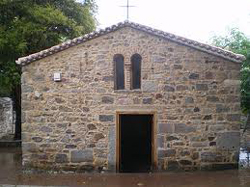Churches and Monasteries
Monastery of Lemonas – Ayios Ignatios: It is situated in the center of the island and at a distance of 3Km Northwestern of the small town Kalloni inside a basin. Its Cathedral is dedicated to the Taxiarches. The Archbishop of Mythimna Iynatio Ayaliano, whose name is given today to the Monastery, built it in 1523. During the years of the Turkish Occupation 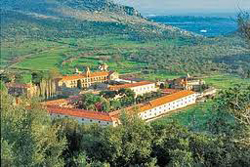 it was the unique intellectual center of the island (during the 16th century here was organized a school for the education of the Lesvians). The Cathedral is an imposing three-aisle basilica, with a fretwork and gold-plated iconostasis, while in the internal we have Byzantine wall paintings of the year 1800. The Monastery holds a Library with 5,000 rare books – from the year of 1502 till today – manuscripts belonging to the period 9th to 19th century, Archbishops’ and Sultan’s documents. The oldest document is a gospel of the 9th century written with golden ink. Also there are : a Museum of Ecclesiastical and Folk Art with a plethora of impressive exhibits as ecclesiastical utensils and various objects, holy icons, fretwork objects etc and the unique in Lesvos Museum of Geology (1990) where we can see the basic Lesvian rocks and the minerals – metals of the island. The Monastery has been a significant center of religious, national, intellectual, social and charity activity especially during the years of the Turkish occupation but even today it continues the charity through an old people’s home and a zoo that are organized. Also we have to notice that inside its territory there are spread many small churches of Byzantine architectural structure.
it was the unique intellectual center of the island (during the 16th century here was organized a school for the education of the Lesvians). The Cathedral is an imposing three-aisle basilica, with a fretwork and gold-plated iconostasis, while in the internal we have Byzantine wall paintings of the year 1800. The Monastery holds a Library with 5,000 rare books – from the year of 1502 till today – manuscripts belonging to the period 9th to 19th century, Archbishops’ and Sultan’s documents. The oldest document is a gospel of the 9th century written with golden ink. Also there are : a Museum of Ecclesiastical and Folk Art with a plethora of impressive exhibits as ecclesiastical utensils and various objects, holy icons, fretwork objects etc and the unique in Lesvos Museum of Geology (1990) where we can see the basic Lesvian rocks and the minerals – metals of the island. The Monastery has been a significant center of religious, national, intellectual, social and charity activity especially during the years of the Turkish occupation but even today it continues the charity through an old people’s home and a zoo that are organized. Also we have to notice that inside its territory there are spread many small churches of Byzantine architectural structure.

Monastery of Panayia Myrsiniotissa: It is situated at a distance of 4Km away from the area of Kalloni. It depends on the Monastery of Lemonas. It is Byzantine, and has been organized by Ayios Iynatios in 1523 dedicated to the Assumption of Virgin Mary. Inside the Cathedral the visitor can admire valuable portable holy icons of the Byzantine art, an old fretwork iconostasis and significant wall paintings. Here was organized a school for girls during the 16th century, significant contribution into the education of the Lesvians during the difficult years of the Turkish occupation.
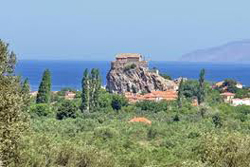
Church of Panayia Glyckofiloussa (Virgin Mary): It is in the village of Petra built on a rock, with114 steps curved on it and which have to be stepped by the pilgrim. The first church possibly hase been built in the year 1609 as the Catholic of a women’s Monastery. The architectural style of the church belongs to the Genuate period and this is proved by the existence of a blazon of Gateluses that was curved on a slab of the garden’s cobble paved floor. Inside the church there are wonderful and rare Byzantine icons and an artistic Metropolitan throne. The extremely fortificated site of the church give to the observer the impression that it was probably built during the pirates’ in cursions of the post-Byzantine period. The church has been reconstructed in 1840. A plethora of pilgrims visit the church especially during the first fortnight of August ( the Assumption of Virgin Mary ). We have to notice here that the view from the yard is fantastic as it combines the picturesque village of Petra, with the Aegean Sea and the isles of the area.
Saint Nicholas church:
We find that church at the village of Petra, beside a huge plane tree. It is a one-isle basilica of the 17th century, decorated with numerous frescoes. The floor of the church is slab-paved, its temple is wooden and gold coated as the bishop’s throne (500 years old ), while there are marble candelabrums too. One of the most impressive fresco is the one that represents the hanging of Judas.
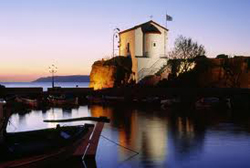 Church of Panayia Gorgona (Virgin Mary the Mermaid): It is at the northwestern of Mytilene ( 48Km ) inside the picturesque port of Skala Sykameneas, built on a small rock beside the sea. It is called Panayia the Mermaid as the homonymous icon represent Virgin Mary with a mermaid’s tail – painted by an unknown folk artist – patron Saint of the fishermen and an icon that inspired the famous Lesbian novelist – Stratis Myrivilis – to write the homonymous novel.
Church of Panayia Gorgona (Virgin Mary the Mermaid): It is at the northwestern of Mytilene ( 48Km ) inside the picturesque port of Skala Sykameneas, built on a small rock beside the sea. It is called Panayia the Mermaid as the homonymous icon represent Virgin Mary with a mermaid’s tail – painted by an unknown folk artist – patron Saint of the fishermen and an icon that inspired the famous Lesbian novelist – Stratis Myrivilis – to write the homonymous novel.
Monastery of Taxiarchis in Mandamados:It is situated on the suburbs of the small town Mandamados, at the site “Lesvados”. It is a Byzantine Monastery abandoned -probably – with the island’s occupation by the Ottomans in 14762. 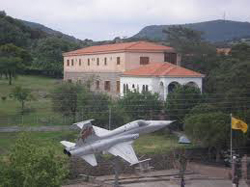 It has kept the tradition of the Monastery since then, while the cells and the garden keep the Monastery’s structure too. The Cathedral has been rebuilt since the year 1879. During the middle of the 19th century there were few monks – as we are informed by the relative ecclesiastical codes. Among the old holy icons one – curved – is distinguished: it is placed inside a glass box, in front of the iconostasis at the Southern isle, and it represent the Archangel Michael. According to the tradition it was made of clay and the blood of the slaughtered monks during the Monastery’s destruction by the Turks.This holy icon creates fear and respect as it represents the Archangel with a strict expression, big eyed and its black color because of time, with a big face, the scaring sword and the gold-plated wings. On the upper side of the icon there is an arch full of tiny holy paintings that represent various religious performances. The particular icon, which is the main pole that attracts the pilgrims, is of pure Byzantine art as it has been sculptured on the basis of relative standards. The church celebrates on Sunday of Myrophores with a great religious and commercial festivity, accompanied by a bull’s sacrifice and the preparation of the traditional dish “kiskek” ( meat cooked with grain ) that is served traditionally to the pilgrims. Also worth noticing is the icon of the Archangel (with gigantic dimension) at the main entrance of the Monastery and the garden that surrounds it, full of green, artistic paved paths, fountains etc.
It has kept the tradition of the Monastery since then, while the cells and the garden keep the Monastery’s structure too. The Cathedral has been rebuilt since the year 1879. During the middle of the 19th century there were few monks – as we are informed by the relative ecclesiastical codes. Among the old holy icons one – curved – is distinguished: it is placed inside a glass box, in front of the iconostasis at the Southern isle, and it represent the Archangel Michael. According to the tradition it was made of clay and the blood of the slaughtered monks during the Monastery’s destruction by the Turks.This holy icon creates fear and respect as it represents the Archangel with a strict expression, big eyed and its black color because of time, with a big face, the scaring sword and the gold-plated wings. On the upper side of the icon there is an arch full of tiny holy paintings that represent various religious performances. The particular icon, which is the main pole that attracts the pilgrims, is of pure Byzantine art as it has been sculptured on the basis of relative standards. The church celebrates on Sunday of Myrophores with a great religious and commercial festivity, accompanied by a bull’s sacrifice and the preparation of the traditional dish “kiskek” ( meat cooked with grain ) that is served traditionally to the pilgrims. Also worth noticing is the icon of the Archangel (with gigantic dimension) at the main entrance of the Monastery and the garden that surrounds it, full of green, artistic paved paths, fountains etc.
The church of Ayios Stephanos at Mantamados:
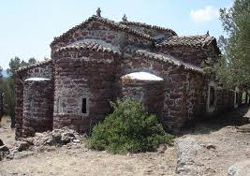 It is at the eastern part of the island, near the small town of Mantamados. It is a cruciform basilica, built in the post Byzantine period. It is very small and was constructed from pink trachyte rock. Initially it had a dome, which collapsed in the 19th century. The roof has been reconstructed with wooden beams and tiles by the villagers. At the eastern part of the church there are three small arches. Another relatively recent construction is the porch. Incorporated in the walls of the church are parts of an older church and a Roman inscription.
It is at the eastern part of the island, near the small town of Mantamados. It is a cruciform basilica, built in the post Byzantine period. It is very small and was constructed from pink trachyte rock. Initially it had a dome, which collapsed in the 19th century. The roof has been reconstructed with wooden beams and tiles by the villagers. At the eastern part of the church there are three small arches. Another relatively recent construction is the porch. Incorporated in the walls of the church are parts of an older church and a Roman inscription.
Monastery of Perivolis: It is situated at the Northwestern of the island and at a distance of 3Km from the small town Antissa, at the sides of river Voulgari. It is an inactive Monastery for women dedicated 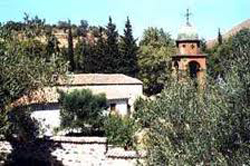 to Virgin Mary. It is Byzantine and has been rebuilt since the year 1630, with the construction and the renovation of the Cathedral, according to the standards of the small dimensions Byzantine basilicas. The name “perivoli” is due to the defense habit of the inhabitants against the pirates’ raids. Worth noticing are the icons of the fretwork iconostasis and the wall paintings ( 16th century ). Also there is a guesthouse and the garden is full of green as the Monastery is built beside the river Voulgari.
to Virgin Mary. It is Byzantine and has been rebuilt since the year 1630, with the construction and the renovation of the Cathedral, according to the standards of the small dimensions Byzantine basilicas. The name “perivoli” is due to the defense habit of the inhabitants against the pirates’ raids. Worth noticing are the icons of the fretwork iconostasis and the wall paintings ( 16th century ). Also there is a guesthouse and the garden is full of green as the Monastery is built beside the river Voulgari.
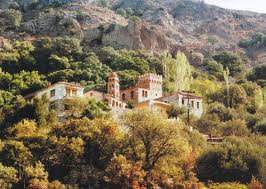 Monastery of Pythariou: It is situated inside a deep gorge at the Northeastern of the small town Eressos ( 3Km ). Its name is due to the natural shape of the landscape. It is dedicated to Taxiarches and its foundation is found during the medieval years. It has been rebuilt during the years of the Turkish occupation. It is a Byzantine Monastery with a plethora of interesting holy icons, ecclesiastical objects and wall paintings. In 1938 a reformatory for Priests was organized and closed in the year 1940. It is a Monastery for men and nowadays is being renovated.
Monastery of Pythariou: It is situated inside a deep gorge at the Northeastern of the small town Eressos ( 3Km ). Its name is due to the natural shape of the landscape. It is dedicated to Taxiarches and its foundation is found during the medieval years. It has been rebuilt during the years of the Turkish occupation. It is a Byzantine Monastery with a plethora of interesting holy icons, ecclesiastical objects and wall paintings. In 1938 a reformatory for Priests was organized and closed in the year 1940. It is a Monastery for men and nowadays is being renovated.
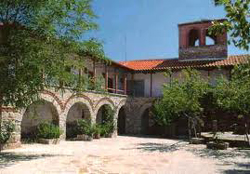 Monastery of Ipsilou: It is situated on the top of the rocky mountain Ordymnos at the boundaries of the regions Mytilene – Mythimna, between Antissa and Sigri and dedicated to Ayios Ioannis Theologos. The choice of its geographical place is the evidence of its Medieval origin ( in 800AD ), while a reconstruction took place during the years of the Turkish occupation ( 16th century ). The Cathedral is distinguished by the wonderful wall paintings and especially of its iconostasis and these who belong to the church of Ayious Pateres too. At the Monastery” file we find precious manuscripts and ecclesiastical objects. After the island’s liberation in 1912 it performed significant social and charity activity.
Monastery of Ipsilou: It is situated on the top of the rocky mountain Ordymnos at the boundaries of the regions Mytilene – Mythimna, between Antissa and Sigri and dedicated to Ayios Ioannis Theologos. The choice of its geographical place is the evidence of its Medieval origin ( in 800AD ), while a reconstruction took place during the years of the Turkish occupation ( 16th century ). The Cathedral is distinguished by the wonderful wall paintings and especially of its iconostasis and these who belong to the church of Ayious Pateres too. At the Monastery” file we find precious manuscripts and ecclesiastical objects. After the island’s liberation in 1912 it performed significant social and charity activity.
Monastery of Ayios Raphael ( Saint Raphael )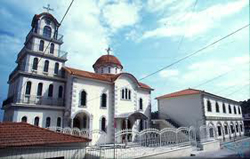 in Thermi: It is situated at the Northeastern and at a distance of 12Km away from Mytilene and 3Km of Thermi on a olive grove covered hill called “Karyes”. The today’s Monastery has been built on the ruins of a post-Christian basilica, which we can see in the surrounding place : wall paintings, a red paved floor, the arch of ayiasma ( holy water ) and the holy icon of Jesus Christ ( painted in the 14th century ), leaves of a membrane belonging to a hand-written Gospel and other interesting ecclesiastical objects. There are three periods in the Monastery’s history : (a) from the 10th century till the year 1235 – year of its destruction because of a pirates’ raid – last abbess Ayia Olympia, (b) from the year 1433 till 1463 – year of its second destruction by the Ottomans – last abbot Ayios Raphael and (c) from the year 1962 till today. It is a woman’s Monastery which has been dedicated to Saint Raphael – his holy skeleton has been found with Ayios Nikolaos and Ayias Irene too, year of their martyrdom 1463. In 1962 the Monastery was founded on the basis of a Greek State’s Regulation. Firstly the Cathedral was built and afterwards the cells and a church dedicated to Ayia Magdalini. All the works and the relative decoration have been paid by offers and donations of pilgrims and under the control of a Committee that had been established by Mytilene’ Metropolis. In 1969 we have the inauguration of the Monastery. The Monastery is directed by the charismatic abbess Evyenia Klidara, a unique personality with significant contribution in the theological studies. The belief in the three Saints has contributed in the establishment of the Monastery as a pan-Christian pilgrimage. Also worth noticing is the natural environment: rich vegetation consisted of olive trees and fantastic view to the Aegean Sea and the Asia Minor coasts. Today the Monastery with the secondary buildings and gardens consists a tiny settlement of the area, contributing into the welfare of the area’s villages with the endless numbers of its pilgrims especially during spring and summer.
in Thermi: It is situated at the Northeastern and at a distance of 12Km away from Mytilene and 3Km of Thermi on a olive grove covered hill called “Karyes”. The today’s Monastery has been built on the ruins of a post-Christian basilica, which we can see in the surrounding place : wall paintings, a red paved floor, the arch of ayiasma ( holy water ) and the holy icon of Jesus Christ ( painted in the 14th century ), leaves of a membrane belonging to a hand-written Gospel and other interesting ecclesiastical objects. There are three periods in the Monastery’s history : (a) from the 10th century till the year 1235 – year of its destruction because of a pirates’ raid – last abbess Ayia Olympia, (b) from the year 1433 till 1463 – year of its second destruction by the Ottomans – last abbot Ayios Raphael and (c) from the year 1962 till today. It is a woman’s Monastery which has been dedicated to Saint Raphael – his holy skeleton has been found with Ayios Nikolaos and Ayias Irene too, year of their martyrdom 1463. In 1962 the Monastery was founded on the basis of a Greek State’s Regulation. Firstly the Cathedral was built and afterwards the cells and a church dedicated to Ayia Magdalini. All the works and the relative decoration have been paid by offers and donations of pilgrims and under the control of a Committee that had been established by Mytilene’ Metropolis. In 1969 we have the inauguration of the Monastery. The Monastery is directed by the charismatic abbess Evyenia Klidara, a unique personality with significant contribution in the theological studies. The belief in the three Saints has contributed in the establishment of the Monastery as a pan-Christian pilgrimage. Also worth noticing is the natural environment: rich vegetation consisted of olive trees and fantastic view to the Aegean Sea and the Asia Minor coasts. Today the Monastery with the secondary buildings and gardens consists a tiny settlement of the area, contributing into the welfare of the area’s villages with the endless numbers of its pilgrims especially during spring and summer.
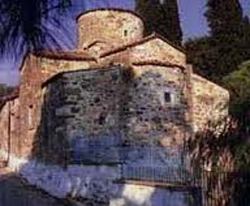
Panayia Troulloti (Virgin Mary with the dome): The church is built at the area of Thermi on a picturesque hill. It is a Byzantine basilica and is one of the oldest Orthodox Christianic monument after the Monastery of Perivolis, that remains nearly untouched from the Byzantine period in Lesvos. According to the tradition, it was built in the 8th century. The church – obviously havimg lost the initial architectural structure because of relative interventions- is dedicated to the Assumption of Virgin Mary. It is called “Troulloti” because the dome’s vault is decorated with the icon of Virgin Mary and not with the usual icon of Jesus Christ.
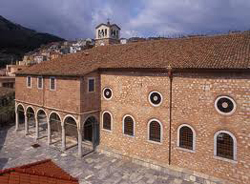 Church of Agia Sion of Agiassos (Virgin Mary in Agiassos) :The name “Agia Sion” dominated as the formal name of the Lesbian small town of Agiassos. This name has been derived from the old holy icon of Virgin Mary, painted and made of mastic and wax – according to the religious tradition – by Saint Luke the Evangelist. During the period of the Iconoclasm the monk Agathon transferred the holy icon from Jerusalem to the island in the year 803 – it is known that Jerusalem is called “Agia Zion”. Agathon founded the monastery that soon became the epicenter of pilgrimage and the primitive cell for the town’s formation. In 1170 the Catholic was built while during the 16th and the 17th century it enjoyed great religious glory. During the 18th century the rural settlement changes as it expands and the wider area is called “Agiassos”.The present church was built in 1814 as the Monastery stopped functioning at the beginning of the 19th century. Except from the holy icon in the church, there are many others equally significant and indicative samples of the Byzantine and post-Byzantine period. Also the church houses an Ecclesiastical Museum with a significant collection of manuscripts, sacristy and other valuable ecclesiastical items. The pilgrimage- during the first fortnight of August -reaches its peak especially on the 15th ( Day of Virgin Maey’s Assumption ).
Church of Agia Sion of Agiassos (Virgin Mary in Agiassos) :The name “Agia Sion” dominated as the formal name of the Lesbian small town of Agiassos. This name has been derived from the old holy icon of Virgin Mary, painted and made of mastic and wax – according to the religious tradition – by Saint Luke the Evangelist. During the period of the Iconoclasm the monk Agathon transferred the holy icon from Jerusalem to the island in the year 803 – it is known that Jerusalem is called “Agia Zion”. Agathon founded the monastery that soon became the epicenter of pilgrimage and the primitive cell for the town’s formation. In 1170 the Catholic was built while during the 16th and the 17th century it enjoyed great religious glory. During the 18th century the rural settlement changes as it expands and the wider area is called “Agiassos”.The present church was built in 1814 as the Monastery stopped functioning at the beginning of the 19th century. Except from the holy icon in the church, there are many others equally significant and indicative samples of the Byzantine and post-Byzantine period. Also the church houses an Ecclesiastical Museum with a significant collection of manuscripts, sacristy and other valuable ecclesiastical items. The pilgrimage- during the first fortnight of August -reaches its peak especially on the 15th ( Day of Virgin Maey’s Assumption ).
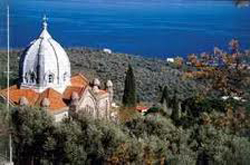
Church of Archangel Gabriel: It is 6km at the southern of Mytilene, at the suburb of kayiani or Taxiarches. It was built in 1903 and it is the third building that has taken the place of the previous two. It is of Byzantine architectural style, cruciform with a Gothic dome. The whole roof of the church has been covered with artistic crosswise vaults decorated with plasterworks. Slabs of white marble cover the floor and in the middle there is a curved two-headed eagle ( symbol of the Byzantine Empire ). The iconostasis and the Metropolite throne – kept from the previous church – are fretwork pieced of art and they belong to the beginning of the 18th century. The church is full of impressive holy icons and wall paintings. On yearly basis numerous pilgrims visit the church. The view from the garden that surrounds it, is fantastic as it faces the port of Mytilene and the Aegean Sea.
Church of Santa Marina: It is at the homonymous village after Taxiarches settlement. It is a three-isle basilica built in 1797. It has an artistic temple wood-curved and an archbishop’s throne created in 1839. The church has walled in architectural parts form a Byzantine church that we find at Mt Amali ( Virgin Mary of Amali ), which offers a fantastic view to a pine tree forest. The church and its yard have been characterized as an archaeological area.
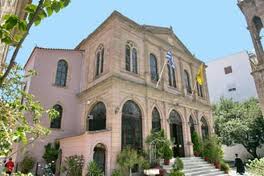
Cathedral of Ayios Athanasios: It is in the center of Mytilene, near the area of the southern port. It was built during the end of the 16th century and it is a three-aisle cruciform basilica. It is dedicated to Ayios Athanassios and in the church the relic of the new martyr Ayios Theodoros of Byzantium -patron saint of the town – is kept ( he martyred in the year 1795 by the Turks ). The fretwork iconostasis has been characterized as one of the most impressive works of post-Byzantine art ( constructed in 1738 ), while the holy icon of Jesus Christ is a wonderful Asia Minor relic painted during the 16th century. Also the belfry is one of Gothic architectural style and it is 33m. high.
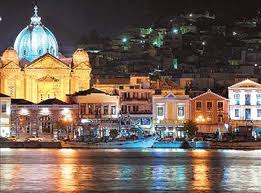 Church of Ayios Therapon: It is an imposing building at the port’s area and the biggest church of Mytilene. It was built in 1860 and it is a cruciform Byzantine basilica. Here the relic of the Metropolitan Bishop Ignatius of Hungary-Wallachia is kept who performed intense national action during the years of the Turkish occupation. Among the impressive holy icons of the church we must notice two Byzantine: of Jesus Christ ( 14th century ) and of Ioanni the Theologian ( 15th century ).
Church of Ayios Therapon: It is an imposing building at the port’s area and the biggest church of Mytilene. It was built in 1860 and it is a cruciform Byzantine basilica. Here the relic of the Metropolitan Bishop Ignatius of Hungary-Wallachia is kept who performed intense national action during the years of the Turkish occupation. Among the impressive holy icons of the church we must notice two Byzantine: of Jesus Christ ( 14th century ) and of Ioanni the Theologian ( 15th century ).
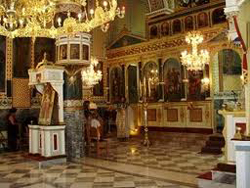
Church of Ayioi Theodori (Saints Theodore): It is the oldest church of Mytilene, built at the edge of the ancient town. It has been built during the Byzantine period and has been reconstructed in the year 1759 with a three-aisle basilica architectural style after it had been destroyed by fire. In the internal we can see the oldest holy icon of Ayios Theodoros the Byzantium – patrol saint of Mytilene – which represents the nine scenes of his martyrdom.
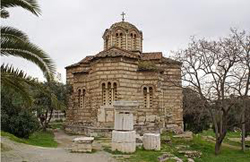
Church of Ayii Apostoli ( Saints Apostles ): It is near the Cathedral and has been built in 1815. It has a worth noticing iconostasis and wonderful wall paintings. At the garden there is a neoclassic building that belongs to the Metropolis of Mytilene and that is used as a religious-intellectual center.
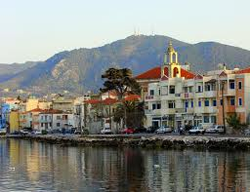
Church of Ayios Nikolaos ( Saint Nicolas ):It is at the area of the old port ( the northern one ), Epano Skala. The building of the Church was an Ottoman Mosque, which was converted into church in the year 1929, to cover the religious needs of the Asia Minor refugees of the area.
Church of Metamorphosis Soteros ( Transfiguration ): It is at the eastern exit of the town, at the site “Therma Kourtzi:. It is believed that there it probably existed an ancient temple dedicated to Apollo or Hera.
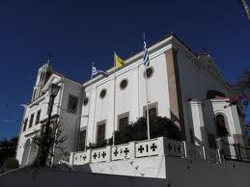
Church of Ayia Barbara: It is at the village of Pamphylla. It is an imposing church built at the beginning of the 20th century. Worth noticing is the iconostasis made of white marble and curved by the famous Greek sculptor G.Chalepas. Interesting is a small marble cistern at the internal of the church and the impressive wall paintings and holy icons.
Other churches of Mytilene are -in the center – of Ayios Georgios and Ayios Symeon, of Ayias Triados – it is being built at the hill of Ayia Kyriaki according to the architectural style of Mount Athos, of Zoodochus Piyis at the western exit of the town, of Ayios Ioannis at the site “Pyrgelia”, of Ayioi Pateres at the site “Chalika”, of Theotokos at the site “Chryssolaloussa” and many other churches are spread dedicated to the honor of many Saints, indicative for the deep religious belief that characterizes the Lesvians.
Church of Metamorphosis Soteros ( Transfiguration ): It is at the eastern exit of the town, at the site “Therma Kourtzi:. It is believed that there it probably existed an ancient temple dedicated to Apollo or Hera.
Monastery of Damandriou: It is situ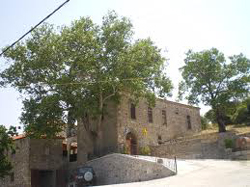 ated at the Eastern of the small town Polichnitos. It is dedicated to the assumption of Virgin Mary and it is said that it has been constructed since the middle of the 14th century. It is a Byzantine Monastery and as relics prove it, in its internal was built the small churches of Ayios Georgios and Myrophores. The medieval Monastery was abandoned during the first years of the Turkish occupation and was probably reconstructed in the 17th century. From the middle of the 19th century it faced the danger of abandonment because of the monks’ lack and for that reason in 1958 an old people’s home was organized there, that has been demolished the last years. In the Cathedral there are wonderful wall paintings of Byzantine art and significant ecclesiastical items.
ated at the Eastern of the small town Polichnitos. It is dedicated to the assumption of Virgin Mary and it is said that it has been constructed since the middle of the 14th century. It is a Byzantine Monastery and as relics prove it, in its internal was built the small churches of Ayios Georgios and Myrophores. The medieval Monastery was abandoned during the first years of the Turkish occupation and was probably reconstructed in the 17th century. From the middle of the 19th century it faced the danger of abandonment because of the monks’ lack and for that reason in 1958 an old people’s home was organized there, that has been demolished the last years. In the Cathedral there are wonderful wall paintings of Byzantine art and significant ecclesiastical items.
Saint George’s Church: It is one of the most artistic and richer churches of Greece. It is a three-isle basilica constructed with impressive architecture and aesthetic. The wood-curved temple, the belfry, the numerous pillars and the valuable holy icons : the representations of the Doomsday, the Day of Judgement, both of them exhibited at the Byzantine Museum of Mytilene, impressing the visitor.
